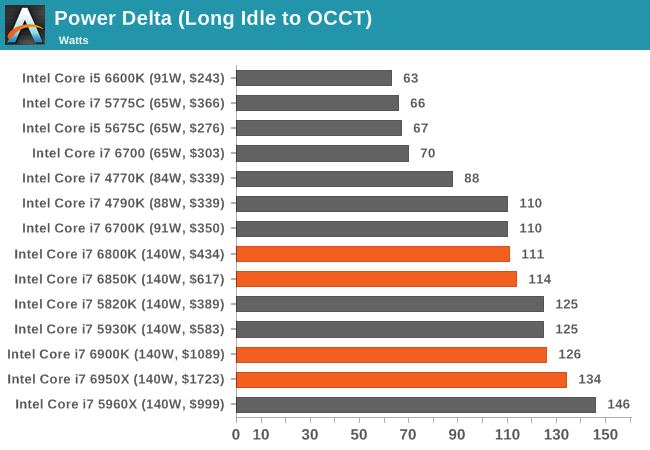The Intel Broadwell-E Review: Core i7-6950X, i7-6900K, i7-6850K and i7-6800K Tested
by Ian Cutress on May 31, 2016 2:01 AM EST- Posted in
- CPUs
- Intel
- Enterprise
- Prosumer
- X99
- 14nm
- Broadwell-E
- HEDT
Load Delta Power Consumption
Power consumption was tested on the system while in a single MSI GTX 770 Lightning configuration with a wall meter connected to the OCZ 1250W power supply. This power supply is Gold rated, and as I am in the UK on a 230-240 V supply, leads to ~75% efficiency > 50W, and 90%+ efficiency at 250W, suitable for both idle and multi-GPU loading. This method of power reading allows us to compare both the power management of the BIOS and the board's ability to supply components with power under load, and includes typical PSU losses due to efficiency.

Each of the Broadwell-E SKUs are rated at 140W, however they vary between 6 cores and 10 cores and with different frequencies. Normally one would assume that the core/frequency ratio would be adjusted to match TDP, but ultimately using more cores can consume more power. We see a distinct increase in power consumption moving up the product stack.
Prime95 Core Loading
For this review, we also looked into peak delta power draw when varying the number of cores using Prime95’s mode for peak power consumption. Prime95 identifies cores with multiple threads and adjusts its loading/pinning accordingly.

Broadwell-E Overclocking
Methodology
Our standard overclocking methodology is as follows. We select the automatic overclock options and test for stability with PovRay and OCCT to simulate high-end workloads. These stability tests aim to catch any immediate issues with memory or CPU errors.
For manual overclocks, based on the information gathered from previous testing, we start off at a nominal voltage and CPU multiplier, and the multiplier is increased until the stability tests are failed. The CPU voltage is increased gradually until the stability tests are passed, and the process repeated until the motherboard reduces the multiplier automatically (due to safety protocols) or the CPU temperature reaches a stupidly high level (100ºC+). Our test bed is not in a case, which should push overclocks higher with fresher (cooler) air.
Overclock Results
Due to time constraints we were only able to overclock the i7-6950X using the MSI X99A Gaming Carbon motherboard. MSI has improved its overclocking options as of late on the Z170 platform to make it easier to use, but our BIOS did not have those most recent updates, particularly for load line calibration. However, our sample hit 4.1 GHz at 1.30 volts before the OCCT load temperatures were prohibitive to move up any further. We saw similar things when testing the mainstream Broadwell parts with Iris Pro, which shows that this sort of overclocking performance might be indicative of the silicon itself.
That being said, speaking with our contacts at various motherboard manufacturers, we're told that 4.1 GHz is a reasonably average processor result for Broadwell-E. Some processors will hit 4.3 GHz on air at around the same voltage, whereas others need up to 1.4 volts, and thus results will depend on the cooling setup used or the thermal characteristics of the silicon. I have also been told that AVX is a different story: for any peak frequency attained normally, AVX overclock stable frequencies will be around 200-300 MHz lower.











205 Comments
View All Comments
mapesdhs - Thursday, June 9, 2016 - link
By definition, professionals wouldn't use this kind of tech at all. Pro users don't oc. Pro users have a budget to afford XEON.The prosumer market though, solo professionals, those on a budget, these are the people for whom previous generations of SB-E/IB-E made some sense, but not anymore.
sleekblackroadster - Tuesday, May 31, 2016 - link
This is the opposite of generating enthusiasm, Intel.jjj - Tuesday, May 31, 2016 - link
This is what Intel means by more focus on certain segments and it will only get worse as the PC market fades away.damianrobertjones - Tuesday, May 31, 2016 - link
No 6700k in the tests? :(damianrobertjones - Tuesday, May 31, 2016 - link
Clicks the next page... DAMMIT!PJ_ - Tuesday, May 31, 2016 - link
It was in the GTA V benchmarks for examplePJ_ - Tuesday, May 31, 2016 - link
And many moremedi03 - Tuesday, May 31, 2016 - link
AMD's CPUs aren't that bad for gaming (mostly because of multi-threading becoming a treand in games, thanks to consoles) as many people think:http://wccftech.com/fx-8370-i5-6400-gaming-compari...
josetesan - Tuesday, May 31, 2016 - link
It will be great if , for next multi-threaded tests, Linux Kernel compilation times were added, as thay make great use of it, via the -J <threads> parameter.Some people use their computers to compile,and we benefit for multicores a lot. ( java, C, whatever ).
I can see the 6-core for $434 it a nice price, given Haswell i7-4770 has 4 cores and is similar priced.
Great review, indeed.
Tom Womack - Tuesday, May 31, 2016 - link
It's not clear that the 6-core Broadwell is very much better than the 6-core Haswell, and it's likely that its existence makes the 6-core Haswell cheaper; so pick up a 5820K in the near term.